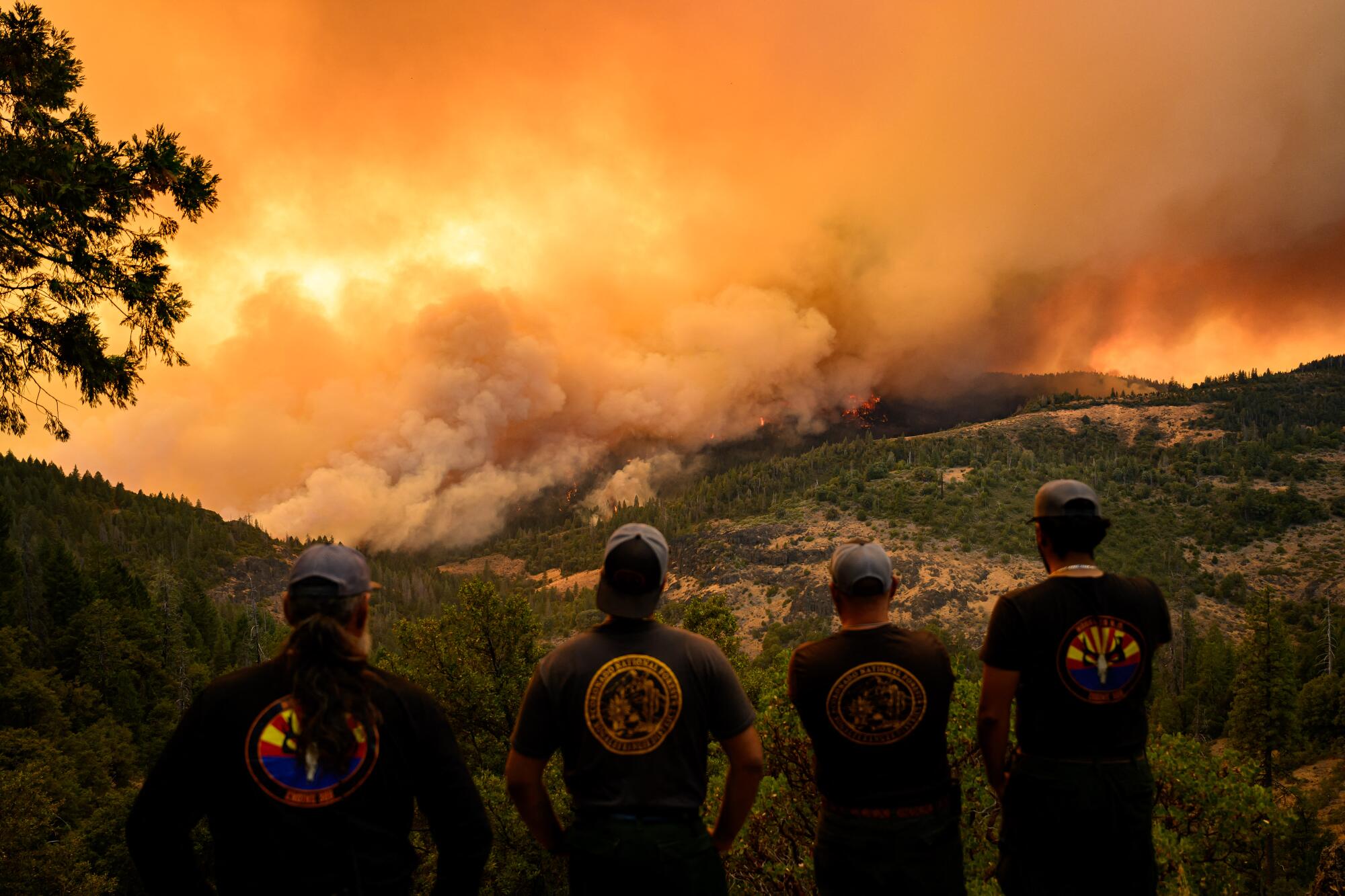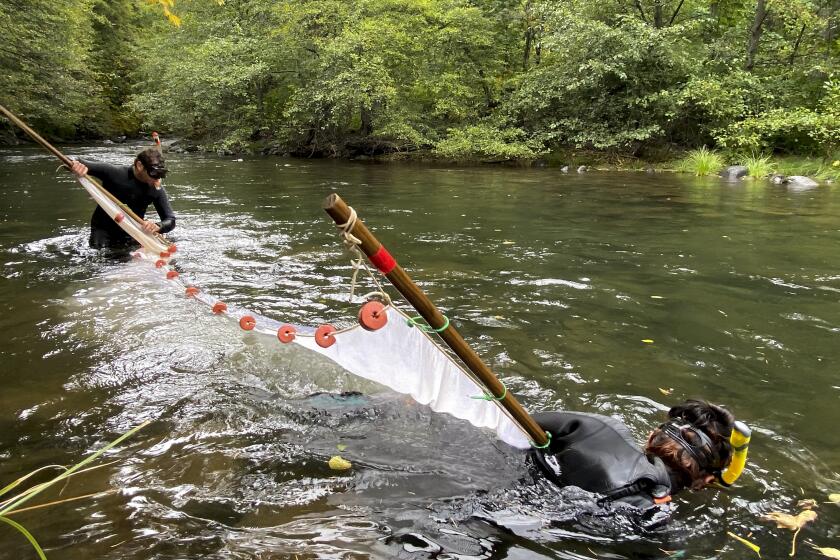
- Share via
California’s spring-run Chinook salmon were already in the midst of a population crash before the Park fire exploded into the state’s fourth-largest wildfire in history. Biologists now worry the fire could push the fish closer to extinction by scorching forests along creeks that provide critical spawning habitat.
The wildfire has been burning through the upper Mill and Deer Creek watersheds, threatening forested canyons that provide some of last intact spawning habitat for spring-run Chinook salmon.
“This fire entering the upper watershed, where we have sensitive spawning and rearing habitat, is concerning,” said Matt Johnson, a senior environmental scientist with the California Department of Fish and Wildlife. “You have a wildfire that is coming at a very inopportune time for the species and a wildfire that’s being driven by a hundred years of fire suppression activities and a warming climate.”
Biologists have begun collecting California’s spring-run Chinook salmon to raise them in captivity in an effort to prevent extinction.
The two creeks are considered vital strongholds for federally threatened spring-run Chinook salmon, which have suffered long-term declines because of water diversions, dams that have blocked them from reaching spawning grounds, and increasingly severe droughts worsened by climate change.
Even before the fire, biologists were so alarmed about a recent crash in the spring-run salmon population that last year they began capturing juvenile fish from Deer Creek to breed them in captivity.
The fire is burning near creek areas where adult fish typically spend weeks swimming in deep pools before spawning in the fall. Juvenile fish that hatched last winter also remain in the creeks this time of year and could be at risk, Johnson said.
Population surveys along the two tributaries of the Sacramento River have been postponed because of the fire.
A man has been charged with arson, accused of starting the fire when he pushed a burning car down a gully in Chico. The suspect denies the accusations.
The suppression of fires in California over the last century has left the forests with a heavy load of fuel.
Biologists are concerned that if the fire burns intensely in the watershed, denuded earth and ash could fill the creeks when rains come, seriously harming water quality and potentially killing fish.
“If we have a really hot fire that cooks the vegetation that holds the soil together, we could have increased sedimentation, debris and ash flow,” Johnson said.
The Park fire’s growth amid steady winds and hot temperatures has been dramatic. It is the seventh-largest wildfire in California history and still growing.
He said that while less intense flames can be beneficial for the ecosystem, a destructive fire that wipes out big trees would loosen the soil, allowing it to wash into the creeks and harm fish.
Severely burned watersheds can also be vulnerable to landslides that come crashing down on creeks.
“We’re still in a holding pattern, watching this fire evolve,” Johnson said. “We’re all quite anxious about the outcome.”
The creeks are sustained by spring-fed streams and snowmelt from Mt. Lassen and surrounding mountains.
The two creeks flow through rocky canyons shaded by pines and Douglas firs, where ferns grow along the banks.
The salmon spawn in late September and October in clear, cold stretches of water, laying their eggs in gravel.

Johnson has been returning to the area regularly for more than 20 years to carry out surveys, walking for miles on trails to reach the spawning areas.
“This is some of the most beautiful salmon habitat remaining in the Central Valley,” Johnson said. “It’s going to hurt to see it if it’s severely damaged.”
Johnson said he hopes the fire might bring a mix of effects — burning intensely in some areas, but leaving other areas less damaged. If the watershed is severely charred, he said, the habitat could be degraded for years or decades to come.
For state scientists who have been working to help salmon, the Park fire could upend their long-term strategy.
“We always had this habitat as a safe bet,” Johnson said. “But now that quality habitat is under threat.”
Because of declining salmon populations, California has canceled fishing in rivers for a second year. The decision mirrors the shutdown of coastal fishing.
Spring-run Chinook were listed as threatened under the federal Endangered Species Act in 1999.
“How bad it is for the fish really depends on the details of how it burns,” said Steve Lindley, director of fisheries ecology at NOAA’s Southwest Fisheries Science Center. “If it’s completely denuding the hillslopes and killing all the vegetation, that’s bad. If it burns right down to the water, that’s bad, too. That often doesn’t happen. The riparian zone around streams often resists burning because it’s quite a bit wetter than the upland vegetation.”
After suffering declines during successive droughts, the reduced populations of spring-run salmon now depend largely on these two creeks, as well as Butte Creek, another tributary of the Sacramento River.
If some of the habitats are lost, Lindley said, “there’s really not a lot to save them elsewhere because there are so few other populations and they’re all relatively small.”
“These populations really suffer during droughts,” Lindley said. “It’s just one thing after another. It’s just been piling on to the point where they’re really on the verge of extinction.”
Boiling Point is a newsletter for people who care about the environment and climate across California, the American West and the globe.
Scientists have warned for years that large, destructive wildfires could harm remaining salmon populations. Lindley and other scientists said in a 2007 report that wildfires in the headwaters of Mill and Deer creeks, as well as Butte Creek, pose a significant threat to spring-run Chinook.
The fish were once abundant in rivers and streams throughout the Central Valley, but dams have blocked them from reaching many of their habitats in mountain streams.
And while the salmon are adapted to survive through California’s natural cycles of fire, their low numbers combined with bigger, more destructive fires now make for a potentially lethal mix.
“What we have now are these mega wildfires that are intensified by climate change. And we have reduced fish populations because of all these other impacts — dams, water extraction, pollution,” said Andrew Rypel, a professor of fish ecology and director of UC Davis’ Center for Watershed Sciences. “They’ve been weakened already by all these other impacts.”
Rypel said he worries that this fire — and others like it — might “either finish them off or make the situation far worse.”











